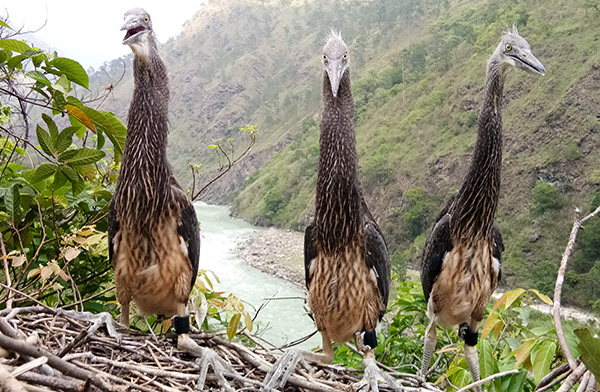 Three White-bellied Heron juveniles were tagged with a global positioning system (GPS) at Kisonachu along the Wangdue-Tsirang highway to understand its movement patterns, lifestyle and distribution.
Three White-bellied Heron juveniles were tagged with a global positioning system (GPS) at Kisonachu along the Wangdue-Tsirang highway to understand its movement patterns, lifestyle and distribution.
The researchers from the Royal Society for Protection of Nature (RSPN) together with the Ugyen Wangchuck Institute for Conservation and Environmental Research (UWICER) jointly tagged White-bellied Heron juveniles on May 14.
The current nest was located by the team from RSPN and officials of the Department of Forests earlier in March this year during its annual population survey. With the incubation period of 30-33 days, the first chicks were expected to hatch in the first week of April. The three juveniles were approximately 40-45 days old when tagged last week.
“It’s hard to capture adults; it’s always good to capture the juveniles when they are still in their nest. After they fledge, it’s quite difficult so it’s always easier and also not so stressful for the birds. So after tagging this time, we have observed the birds for several days basically to see if they are acting normally or whether they are stressed but fortunately, everything was normal,” Jigme Tshering, the Dy. Chief Project Officer of RSPN said.
The three tagged juveniles have been named as Sangay, Chhoe and Gaedhen, referring to the Triple Gem. With the tracking system installed on the three White-bellied heron juveniles, the team can now track their movements and gather essential data on these birds ensuring that their species survives.
Jigme Tshering said GPS tagging is one of the most effective and commonly used for studying wildlife.
“For White-bellied Heron, because it is a critically endangered species, we have to be a bit careful about studying them. So through GPS tagging, we can actually understand their habitat, their behaviour remotely without going having to go into the field and studying.”
RSPN first tagged two juvenile birds in 2016 at Burichu with the help of an expert from the Czech Republic in the process of rescuing the two juveniles.
“For three months we could actually access the transmitter emitted data but somehow we lost and later on we found out that one of the tags was cut, probably the bird died. The minimum life of that GPS is ten years. So for ten years, you can actually access data and then study the movement of the wildlife you are studying.”Jigme Tshering added.
The International Union for Conservation of Nature categorises White-bellied Heron as critically endangered with an estimated world population of fewer than 250.
Bhutan is among the only three countries in the world that hosts the endangered bird species. As per the nationwide White-bellied Heron population survey 2019, there are 25 White-bellied Herons in the country today.








